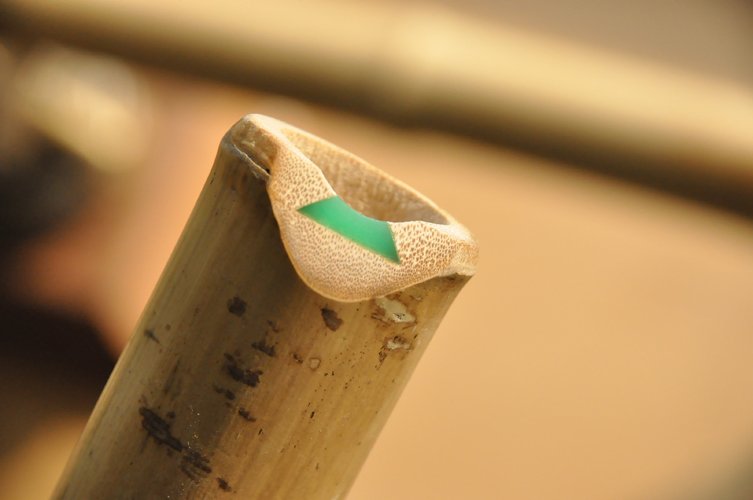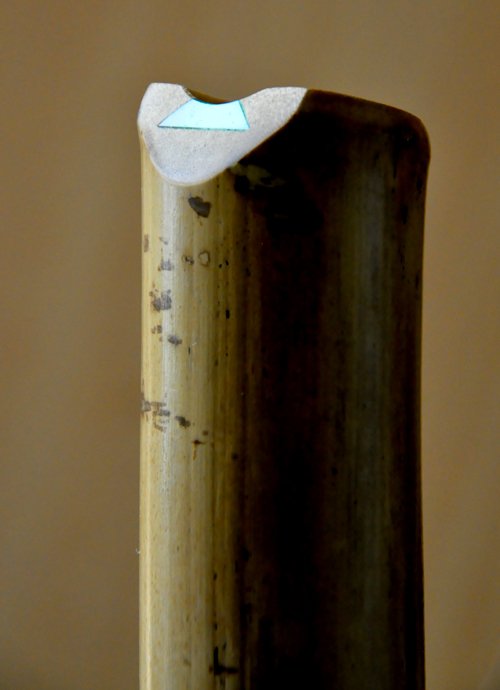Kinko vs Tozan Ryn Utaguchi
Kinko vs Tozan Ryn Utaguchi
Hello everyone, greetings from a newcomer. I am an amateur, novice fan of shakuhachi making from China. I have been trying to make ones with kinko utaguchi and the attached photos are my latest piece last week. Now I want to explore into making tozan ryn utaguchi but feel that it is a daunting challenge because of its curved bamboo area and inlay, as well as its intricacy of inserting the inlay (I tried a couple of attempts before but ended in failure…)
I wrote to Mr. Perry Yung to seek for his advice via email and he kindly gave me some useful tips. Perry also encouraged me to join this forum so that he can share more ideas with me as well as other makers, so here come this posting.
I will try again to make a tozan ryn utaguchi the next couple of days. Should I be lucky enough to have some success, I will keep you posted. In the meantime, your advice and recommendations on this (tools, methods, materials to be used….) are most appreciated!

I wrote to Mr. Perry Yung to seek for his advice via email and he kindly gave me some useful tips. Perry also encouraged me to join this forum so that he can share more ideas with me as well as other makers, so here come this posting.
I will try again to make a tozan ryn utaguchi the next couple of days. Should I be lucky enough to have some success, I will keep you posted. In the meantime, your advice and recommendations on this (tools, methods, materials to be used….) are most appreciated!

Welcome to the forum!
Wow! I must say that green utaguchi inlay makes it look like a sci fi shakuhachi! Very cool! What is the material?
Wow! I must say that green utaguchi inlay makes it look like a sci fi shakuhachi! Very cool! What is the material?
"New Beijingfan""New Beijingfan"
I wrote to Mr. Perry Yung to seek for his advice via email and he kindly gave me some useful tips. Perry also encouraged me to join this forum so that he can share more ideas with me as well as other makers, so here come this posting.
I will try again to make a Tozan ryn utaguchi the next couple of days. Should I be lucky enough to have some success, I will keep you posted. In the meantime, your advice and recommendations on this (tools, methods, materials to be used….) are most appreciated!
Good to see you here! Nice work.Thanks for joining the ESS Forum.
I prefer a public dialogue on these things since I often answer the same questions repeatedly.
I will be doing an inlay replacement on a Tozan Ryu shakuhachi in a day or two and will upload some photos for you to see my process. I learned this style of inlay from two different Japanese makers in Japan. Everyone's method is different to some degree so I encourage you to learn as much as possible about small, micro hand files and razor knives and then experiment and explore. You'll find what works for you.
Hi Edwin, Nei Ho.
Here is my process on making a Kinya Sogawa style inlay. It's similar to Tozan (more similar to Myoan), but more difficult because of the slanted sides. The Tozan is horizontal at the top so you won't have to deal with those angles. I only replace Tozan inlays on repairs, not make new flutes with them and I realized that you probably need to see how the shape is carved out. I posted only the essential photos. Let me know if you need more.
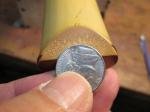
Make the outline first. An American nickel works for this size flute.
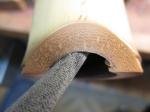
Start with small, medium half-round file then switch to smaller file as you near the corner. File downward only around 45 degree or deeper.
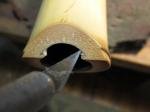
Use razor knife for the corner.
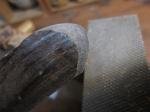
Shape material to match angles of filing. (again, around 45 degree or deeper).
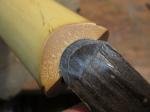
For Tozan, the back is left flat for the top horizontal line. For Sogawa style, back is filed at 45 degree.
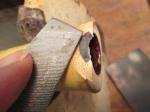
Glue then cut off with saw. File then finish with fine grit sandpaper on wood block.
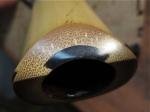
A quick polish to see where this one is at before finishing. It's going to come down another milimeter.
Let me know how it goes.
- Perry
Here is my process on making a Kinya Sogawa style inlay. It's similar to Tozan (more similar to Myoan), but more difficult because of the slanted sides. The Tozan is horizontal at the top so you won't have to deal with those angles. I only replace Tozan inlays on repairs, not make new flutes with them and I realized that you probably need to see how the shape is carved out. I posted only the essential photos. Let me know if you need more.

Make the outline first. An American nickel works for this size flute.

Start with small, medium half-round file then switch to smaller file as you near the corner. File downward only around 45 degree or deeper.

Use razor knife for the corner.

Shape material to match angles of filing. (again, around 45 degree or deeper).

For Tozan, the back is left flat for the top horizontal line. For Sogawa style, back is filed at 45 degree.

Glue then cut off with saw. File then finish with fine grit sandpaper on wood block.

A quick polish to see where this one is at before finishing. It's going to come down another milimeter.
Let me know how it goes.
- Perry
Wow! Perry, thanks so much for the photos which answer quite a lot of my questions. It seems that this requires a high level of craftsmanship and a lot of practice....Edwin
My Pleasure. Please let me know if you need more help. The experience of crafting is as exciting as playing 
BTW, are there many shakuhachi players in Beijing?

BTW, are there many shakuhachi players in Beijing?
Dear Perry,
There is a growing number of shakuhachi lovers in China but they are scattered in many different cities....Also some of them (one of them is me) like to play "hybrid" shakuhachi - a wind instructment with Shakuhachi's utagachi but its finger holes are in accordance with the 8-hole scale of modern Chinese xiao.
There is a growing number of shakuhachi lovers in China but they are scattered in many different cities....Also some of them (one of them is me) like to play "hybrid" shakuhachi - a wind instructment with Shakuhachi's utagachi but its finger holes are in accordance with the 8-hole scale of modern Chinese xiao.
"New Beijingfan""New Beijingfan"Dear Perry,
There is a growing number of shakuhachi lovers in China but they are scattered in many different cities....Also some of them (one of them is me) like to play "hybrid" shakuhachi - a wind instrument with Shakuhachi's utagachi but its finger holes are in accordance with the 8-hole scale of modern Chinese xiao.
That is fascinating! Do you know when the use of this Hybrid instrument came about? The last ten or twenty years? Or more? And was it invented by one particular person or school?
Répondre

